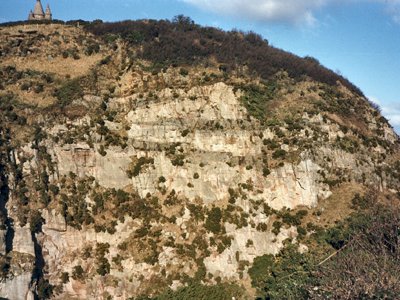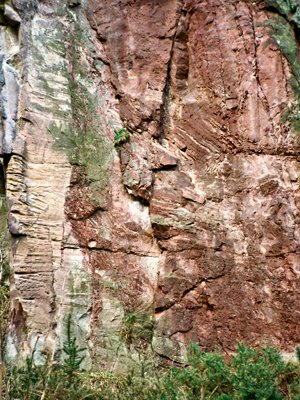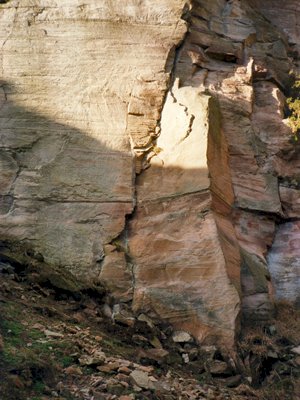Earth Science Conservation Review
| Scrabo Hill - Palaeogene | Down |
| Site Type: | Quarry (disused) |
| Site Status: | ASSI |
| Council area: | Ards Borough Council |
| Grid Reference: | J479725 |
| Google maps: | 54.57957,-5.71256 |
| Rocks | |
|---|---|
| Rock Age: | Tertiary, Triassic (Eocene, Lower Triassic, Palaeocene) |
| Rock Name: | Sherwood Sandstone Group |
| Rock Type: | Dolerite, Sand, Sandstone |
| Interest | |
| Other interest: | Building stone, breccia, dyke, sill, tuff, volcanic vent, Intrusion, The area is designated as a Country Park. |
Summary of site:
The sedimentary rocks of Scrabo Hill are fully described as site 1200 (Scrabo Hill – Triassic) where there is also an outline of Tertiary intrusions. This account concentrates on the history of Tertiary intrusions seen in the quarries and around the hill.
The south quarry of Scrabo Hill is internationally famous because images of the Tertiary transgressive sills were the subject of photographs taken by Robert Welch and extensively used in English language geology and geomorphology text books including all editions of Arthur Holmes's Principles of Physical Geology.
The hill itself owes its existence to a massive dolerite sill capping and protecting the softer Triassic Sherwood Sandstone beneath. The main erosive force shaping this landscape was the succession of ice sheets that ground the bedrock for a substantial part of the last 1.5 million years. The final phase fed ice from the Lough Neagh Basin over this area creating a crag and tail structure at Scrabo. The steep scarps, the crag, faced into the ice flow, the long descending lee slope forming the tail.
In early Tertiary times just over 60 million years ago molten magma with a basaltic composition was injected above the Triassic sandstones in the form of a massive sill. Its surviving remnant is 4 km long, 2.5 km wide and 60 m thick. It stands directly on the sandstones and in places the sill actually incorporates small raft of detached sandstone. Below this cap transgressive sills (sills stepping up and down between bedding planes) from 60 to 90 cm thick form prominent features best seen in the south quarry. Massive north west trending dolerite dykes up to 3 m thick cut through both the minor and the capping sills.
Other volcanic features are present in the south quarry. Red sandstone breccias pass vertically through the sandstones and a 10 cm wide dyke filled with volcanic ash can also be seen. In the top level of the quarry in the south west corner there is a fine example of a volcanic vent filled with sandstones, clays and rotten basalt blocks supported by a much fractured sandstone wall rock. Late intrusions of molten magma invaded this breccia and chilled against it.
Interesting minerals coat fracture surfaces, among them apatite, sphene, sphalerite, hematite, rutile, tremolite, diopside and calcite.
The basaltic magma was injected into the sandstones from depth and gases and lava under pressure exploited the naturally fractured sandstones to escape to the surface. The contact of molten magma with the groundwater in the porous sandstones created violent explosions which ripped through the sandstones, pulverising them in places, leaving a litter of angular blocks in the vents. The mineral veneers possibly date from this early activity. The injection of the sills, major and minor, followed this phase and some substantial remnants to the south and up to 5 km west of the hill may once have been continuous with the main sill. There is no surviving evidence of surface eruption but it could easily have been stripped by erosion and the extensive displacement of sandstone by explosive activity suggests that the vents were fairly shallow, freely venting to the surface.
The intense heating of the sandstones in contact with the magma created a high temperature form of quartz called tridymite, normally stable between 900 and 1,450 degrees giving some idea of the temperatures involved.
The large dykes cutting through the entire sequence were the final volcanic events, the best one visible on the right of the entrance to the south quarry.
This is a superb site for demonstrating the wide range of sedimentary features in the Sherwood Sandstone and the igneous structures are clearly displayed although at present they are becoming masked by vegetation which should be cleared. A case could be made for limited quarrying to present some of the features to better advantage.
The site is a designated Area of Special Scientific Interest.
The south quarry of Scrabo Hill is internationally famous because images of the Tertiary transgressive sills were the subject of photographs taken by Robert Welch and extensively used in English language geology and geomorphology text books including all editions of Arthur Holmes's Principles of Physical Geology.
The hill itself owes its existence to a massive dolerite sill capping and protecting the softer Triassic Sherwood Sandstone beneath. The main erosive force shaping this landscape was the succession of ice sheets that ground the bedrock for a substantial part of the last 1.5 million years. The final phase fed ice from the Lough Neagh Basin over this area creating a crag and tail structure at Scrabo. The steep scarps, the crag, faced into the ice flow, the long descending lee slope forming the tail.
In early Tertiary times just over 60 million years ago molten magma with a basaltic composition was injected above the Triassic sandstones in the form of a massive sill. Its surviving remnant is 4 km long, 2.5 km wide and 60 m thick. It stands directly on the sandstones and in places the sill actually incorporates small raft of detached sandstone. Below this cap transgressive sills (sills stepping up and down between bedding planes) from 60 to 90 cm thick form prominent features best seen in the south quarry. Massive north west trending dolerite dykes up to 3 m thick cut through both the minor and the capping sills.
Other volcanic features are present in the south quarry. Red sandstone breccias pass vertically through the sandstones and a 10 cm wide dyke filled with volcanic ash can also be seen. In the top level of the quarry in the south west corner there is a fine example of a volcanic vent filled with sandstones, clays and rotten basalt blocks supported by a much fractured sandstone wall rock. Late intrusions of molten magma invaded this breccia and chilled against it.
Interesting minerals coat fracture surfaces, among them apatite, sphene, sphalerite, hematite, rutile, tremolite, diopside and calcite.
The basaltic magma was injected into the sandstones from depth and gases and lava under pressure exploited the naturally fractured sandstones to escape to the surface. The contact of molten magma with the groundwater in the porous sandstones created violent explosions which ripped through the sandstones, pulverising them in places, leaving a litter of angular blocks in the vents. The mineral veneers possibly date from this early activity. The injection of the sills, major and minor, followed this phase and some substantial remnants to the south and up to 5 km west of the hill may once have been continuous with the main sill. There is no surviving evidence of surface eruption but it could easily have been stripped by erosion and the extensive displacement of sandstone by explosive activity suggests that the vents were fairly shallow, freely venting to the surface.
The intense heating of the sandstones in contact with the magma created a high temperature form of quartz called tridymite, normally stable between 900 and 1,450 degrees giving some idea of the temperatures involved.
The large dykes cutting through the entire sequence were the final volcanic events, the best one visible on the right of the entrance to the south quarry.
This is a superb site for demonstrating the wide range of sedimentary features in the Sherwood Sandstone and the igneous structures are clearly displayed although at present they are becoming masked by vegetation which should be cleared. A case could be made for limited quarrying to present some of the features to better advantage.
The site is a designated Area of Special Scientific Interest.
| Enlander, I., Dempster, M. & Doughty, P., 2025. Scrabo Hill - Palaeogene, County Down, site summary. [In] Earth Science Conservation Review. https://www.habitas.org.uk/escr/summary.php?item=1117. Accessed on 2025-04-03 |
| Previous Site | Next Site |



